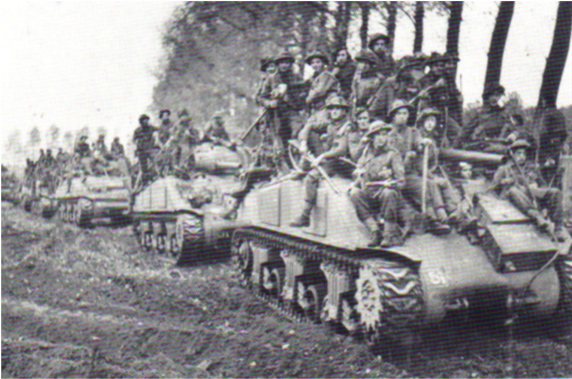The Low Countries
October - December 1944

5th Camerons carried on Shermans
show infoDescription:
5th Camerons carried on Shermans of the 1st Northamptonshire Yeomanry to their assembly area near Kaatsheuval on 21st October 1944.
Copyright:
Queens Own Highlanders Museum
Tags:
In late September the 51st Highland Division moved east through France and into Belgium to relive the 15th Scottish Division on a line from St Odenrode to Eindhoven protecting the supply corridor to Nijmegen. The place of 154 Brigade still at Dunkirk, was taken by 158 Brigade of the 53rd Division but 154 Brigade returned to the Division on 19 October. The next phase of the campaign was to establish Antwerp as an operating port and clear the Germans south of the River Maas.
51st Highland Division with 7th Armoured, 15th Scottish, 33rd Armoured and 53rd Welsh Divisions formed the 12th Corps charged with this task. The Battle of Maas, Operation Colin, would start on the 23rd October for the Division. On the previous day 53rd Welsh and 7th Armoured Divisions would clear the area to the east between Zuid Willems Canal and s'Hertogenbosck and the day after the 51st Highland Division attack, 15th Scottish Division on the left would capture Tilburg and push north.
The 53rd Division had been task with the operation to clear the "Island" were moved to support the US sector against a German counterattack and the task was given to 51st Highland Division. The "Island" was west of s'Hertogenbosch and was about six miles long and four miles deep formed between the Afwaterings canal and the River Maas.

The Advance on Hertogenbush
show infoDescription:
2nb Seaforth Highlanders, 152 Brigade, advancing in Bren Gun Carriers towards Schijndel, 24th Oct 1944
Copyright:
Imperial War Museum - B 11204
Tags:
Enemy counter attack against the US, which had required the 53rd Division to be retasked, had been restricted but they had established a bridgehead across the River Maas, between Venlo and Roermond, threatening Eindhoven. To push the Germans back over the Maas was the next task and this was named Operation Ascot.
The Division now moved north to support the allied bridgehead between the River Waal and the River Rijn west of Nijmegen and Arnhem. On 2nd December the Germans blew the Lek dyke and flooded the "Island". Such an act had however been foreseen and Operation "Noah" was implemented to evacuate the "Island".
